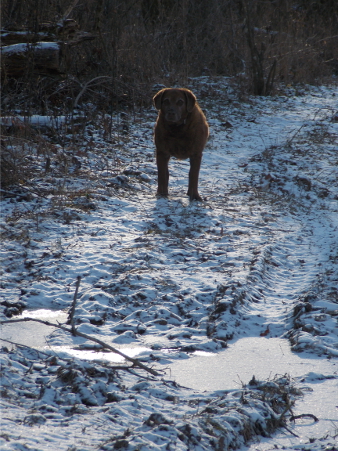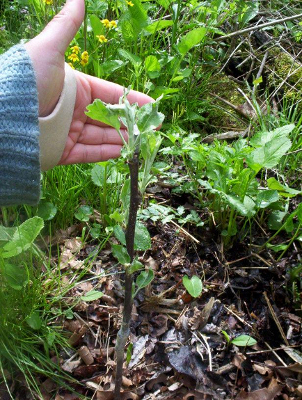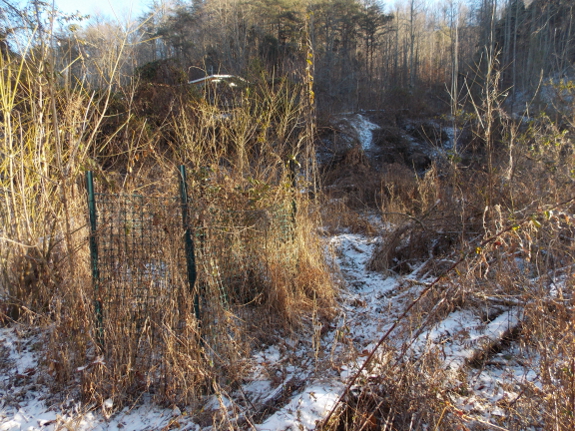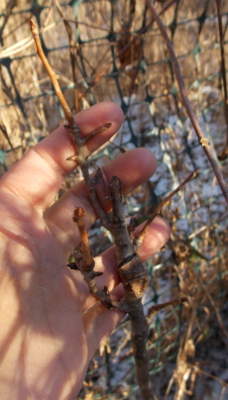
Planting beyond the perimeter
 "Have you thought about planting fruit trees and perennials around the
border of your property. The part of your property you don't think you
can get to do anything with for years, because of the projects you have
going on so close to home.
I was thinking of fruit trees and blackberry bushes. Also, straw
berries. If they grow without your help, GREAT! If not, try a different
spot for next year."
"Have you thought about planting fruit trees and perennials around the
border of your property. The part of your property you don't think you
can get to do anything with for years, because of the projects you have
going on so close to home.
I was thinking of fruit trees and blackberry bushes. Also, straw
berries. If they grow without your help, GREAT! If not, try a different
spot for next year."
We've been getting a lot
of good comments on the blog lately and I realized this one has actually
been asked two or three times over the years, which probably means
another dozen of you are silently wondering the same thing. I have
tried planting beyond our perimeter about half a dozen times, and each
planting has failed. Here's a quick rundown on reasons why in case
you were thinking of trying it at home.
 The first planting beyond the perimeter was when we set out our baby fruit trees before moving to the farm. There was
no perimeter. Every one of these trees perished between not being
taken care of during droughts and becoming deer dinners.
The first planting beyond the perimeter was when we set out our baby fruit trees before moving to the farm. There was
no perimeter. Every one of these trees perished between not being
taken care of during droughts and becoming deer dinners.
My next experiment came
after we moved to the farm. I planted several beds of strawberries
in what is now the blueberry patch, at the extreme south end of our
current perimeter. At that time, that area was beyond the deer deterrents
which kept deer (mostly) out of our main garden, so the results were
predictable. Bambi came and ate every strawberry plant into the
ground.
I thought I'd learned my
lesson, but then decided maybe I could get away with planting an
Illinois everbearing mulberry tree outside our normal chicken pastures,
in an area that we hope will eventually become a pasture
extension. This time, the killer wasn't deer; it was
honeysuckle. The vines swallowed the poor tree whole, and since I
didn't pay any attention to it (past the perimeter, remember), I didn't
disentangle the tree until too late. Another $10 down the drain.

 Two
years ago, I really wanted to add another pear tree to our homestead,
but couldn't figure out where to fit it within our perimeter. I'd
read that pear trees are more able to handle wet feet than any other
fruit tree, so I thought it might be able to survive down in the
powerline cut, where at least the canopy is open. I thought I was
learning from my mistakes by erecting a little cage around the tree out
of plastic trellis material to keep the deer out. And I might have
even dumped a few leaves on the ground as a rough mulch.
Two
years ago, I really wanted to add another pear tree to our homestead,
but couldn't figure out where to fit it within our perimeter. I'd
read that pear trees are more able to handle wet feet than any other
fruit tree, so I thought it might be able to survive down in the
powerline cut, where at least the canopy is open. I thought I was
learning from my mistakes by erecting a little cage around the tree out
of plastic trellis material to keep the deer out. And I might have
even dumped a few leaves on the ground as a rough mulch.
And that pear tree did
survive. The deer didn't eat it, although the honeysuckle vines
tried. But, two years later, the tree has only put out the tiny
bit of new growth you see here. I suspect that if I ever decide
the powerline cut is part of our core homestead and bring that zone into
line, I could plant another tree and it would quickly surpass this
stunted pear.
You, on the other hand,
might want to try outside-the-perimeter planting...as long as your
circumstances are very different from ours. If you have an
established pasture or lawn area (so, no heavy weed pressure except from
grass), you might get away with laying down a kill mulch, planting into
it, and expecting a fruit tree to survive without care. If you're
experimenting with growing fruit trees from seed, your cost will be
nothing, so the experiment will make more sense. And if you don't
have heavy deer pressure, everything becomes much simpler there
too. Sepp Holzer writes about his experiments in this type of situation in his book.
All of that said, I think
there's also an argument to be made for keeping all of your energy
close to home. Small areas can yield huge amounts of food if you
give the plants plenty of mulch and attention, and it might be better to
focus on what you're going to notice every day rather than scattering
your dreams across a large homestead. That's the technique I plan
to follow in the future...unless I absolutely need to put in another tree, that is, and can't find room anywhere else....
Want more in-depth information? Browse through our books.
Or explore more posts by date or by subject.
About us: Anna Hess and Mark Hamilton spent over a decade living self-sufficiently in the mountains of Virginia before moving north to start over from scratch in the foothills of Ohio. They've experimented with permaculture, no-till gardening, trailersteading, home-based microbusinesses and much more, writing about their adventures in both blogs and books.
Want to be notified when new comments are posted on this page? Click on the RSS button after you add a comment to subscribe to the comment feed, or simply check the box beside "email replies to me" while writing your comment.

Planting fruit and nut trees out in a more remote area is exactly where my thinking has evolved over this past year. Two things have happened - the deer and elk (which go through fences, not over) ate everything down in our main homestead orchard - which is luckily still mostly berries, though a few trees were seriously hit) and I spent more time in the neighboring cattle pasture a couple of miles down the road and have discovered various fruit and nut trees which are decades old, completely browsed at cattle and wildlife level, but producing with absolutely no care above that level (standard size trees.)
If standard size fruit and nut trees are the way to go over the longer term, then I simply don't have the space for them in the main homestead orchard. So we hope to work more on protecting the main homestead orchard and start to plant what will become both a wildlife and human orchard of standard size fruit and nuts - maybe an acre or more on a hillside at quite a distance away, in the middle of the forest. This other hillside has an unused and slightly worn large greenhouse (was a 'grow' site at some point in the past; we use it for out of the weather storage for things not so sensitive to light. we also cure firewood in it - the ends are open for ventilation.) It has a lot of weed trees. About an acre was fenced some 10 years ago for goats and I believe they had turkeys over there at some point. I've been slowly taking down the woven wire fence because I don't anticipate ever trying livestock over there - and can use the steel fence posts elsewhere, including individual tree protection. It is a longer term endeavor, but I'm hoping to establish apple, pear, fig, mulberry, american persimmon, chestnut, walnut, and hazelnut trees. The neighbor's cattle pasture has some of these and also plum and cherry. The cherries are never harvested by people because of birds. We did get great plums last year from the pasture, so I might also try to add a plum or two. This would also be the future place to hunt on the property; both a wildlife and human orchard with standard size trees in sufficient health and number that there would be plenty for browsing, etc.
I'm thinking I will try to establish my own rootstock from seedlings, with a first attempt from antonovka apple seeds. Apples and nuts will be the first priorities and hopefully I will get some small experimenting this coming year. I'm also planning to log about 50 acres and transition to douglas fir in the forest. That will also be a huge learning curve. So I don't want to take on too much. On the other hand standard size fruit and nuts will be about 10 years before coming into full swing; no time like the present!